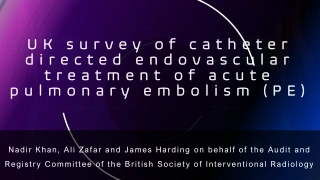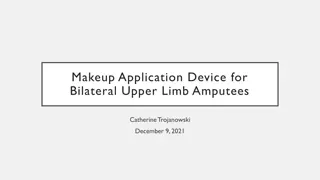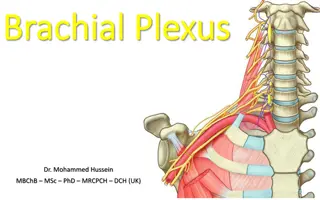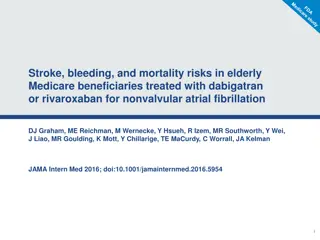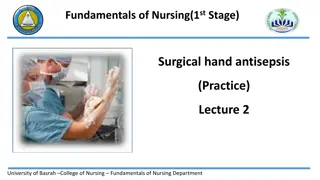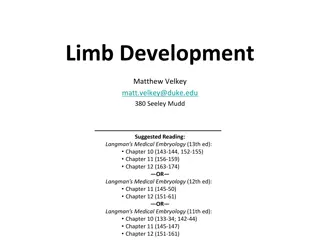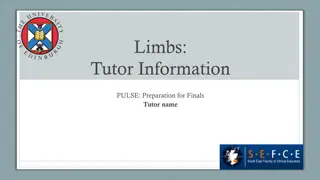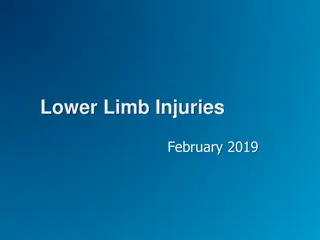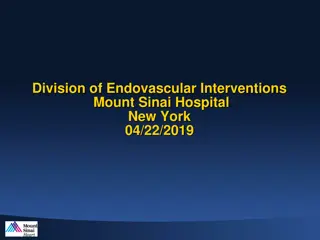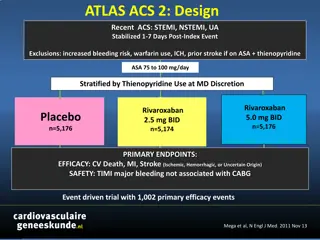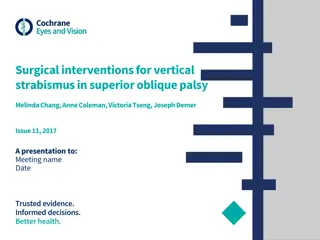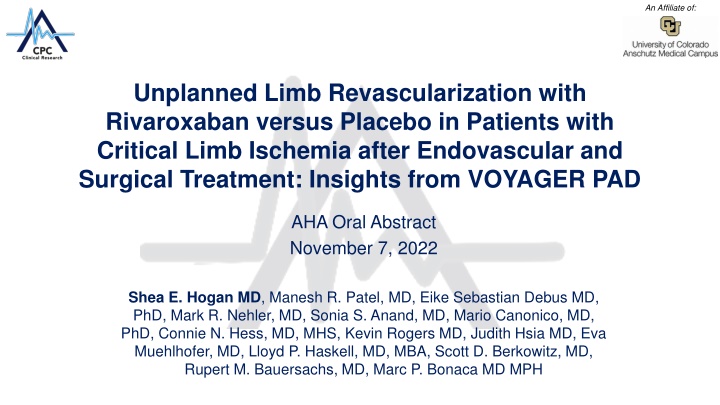
Insights from Unplanned Limb Revascularization with Rivaroxaban vs Placebo in Critical Limb Ischemia Patients
This study discusses the comparison of unplanned limb revascularization outcomes using Rivaroxaban versus placebo in patients with critical limb ischemia post endovascular and surgical treatments. Insights from the VOYAGER PAD AHA Oral Abstract reveal significant findings that shed light on improving outcomes in this patient population.
Download Presentation

Please find below an Image/Link to download the presentation.
The content on the website is provided AS IS for your information and personal use only. It may not be sold, licensed, or shared on other websites without obtaining consent from the author. If you encounter any issues during the download, it is possible that the publisher has removed the file from their server.
You are allowed to download the files provided on this website for personal or commercial use, subject to the condition that they are used lawfully. All files are the property of their respective owners.
The content on the website is provided AS IS for your information and personal use only. It may not be sold, licensed, or shared on other websites without obtaining consent from the author.
E N D
Presentation Transcript
An Affiliate of: Unplanned Limb Revascularization with Rivaroxaban versus Placebo in Patients with Critical Limb Ischemia after Endovascular and Surgical Treatment: Insights from VOYAGER PAD AHA Oral Abstract November 7, 2022 Shea E. Hogan MD, Manesh R. Patel, MD, Eike Sebastian Debus MD, PhD, Mark R. Nehler, MD, Sonia S. Anand, MD, Mario Canonico, MD, PhD, Connie N. Hess, MD, MHS, Kevin Rogers MD, Judith Hsia MD, Eva Muehlhofer, MD, Lloyd P. Haskell, MD, MBA, Scott D. Berkowitz, MD, Rupert M. Bauersachs, MD, Marc P. Bonaca MD MPH
Disclosures VOYAGER PAD funded through a grant from Bayer to CPC Clinical Research CPC, a non-profit academic research organization affiliated with the University of Colorado, that receives research grant/consulting funding from: Abbott, Agios, Alexion Pharma, Alnylam, American Heart Association, Amgen, Angionetics, Anthos Therapeutics, ARCA Biopharma, Array, AstraZeneca, Atentiv, Audentes, Bayer, Better Therapeutics, Brigham and Women s Hospital, Bristol-Myers Squibb, Cambrian Biopharma, Cardiol Therapeutics, CellResearch, Cook Regentec, CSL Behring, Eidos Therapeutics, EP Trading Co, EPG Communications, Epizon Pharma, Esperion Therapeutics, EverlyWell, Exicon Consulting, Faraday, Fortress Biotech, Heartflow, Insmed, Janssen, Kowa Research, Lexicon, Medtronic, Merck, Moderna, NIH, Novartis, NovoNordisk, Pfizer, PhaseBio, PPD Development, Prothena Biosciences, Regeneron, Regio Biosciences, St. Luke s Hospital of Kansas City, Sanifit Therapeutics, Sanofi, Silence Therapeutics, Stealth BioTherapeutics, Thrombosis Research Institute, University of Colorado, University of Pittsburgh, VarmX, Worldwide Clinical Trials, Wraser, Yale Cardiovascular Research Group. An affiliate of:
Critical Limb Ischemia MACE or MALE in PAD with vs. without CLTI on ASA, >80% on statins in VOYAGER PAD Acute limb ischemia, major amputation for vascular cause, myocardial infarction, ischemic stroke, CV death 30 30 Over 230 million individuals worldwide are estimated to have PAD (>10% of individuals >40 years old) and >10% of those having Critical Limb Threatening Ischemia (CLTI). 26.9% CLI N=1533 25 25 +10.2% CLTI represents the most severe manifestation of late-stage peripheral artery disease. 20 20 Cumulative Incidence (KM%) 16.7% 15 15 10.7% Outcomes after CLTI are poor with high risk of ischemic complications and amputation with subsequent mortality rates estimated as high as ~48% Claudication N=5031 +5.8% 10 10 5 5 Revascularization is recommended (Class I) to prevent/minimize tissue loss 4.9% 0 0 0 0 90 90 182 274 366 456 547 639 731 821 912 10041096 182 274 366 456 547 639 731 821 912 10041096 Days from Randomization Bonaca et al. NEJM 2020 Tsao et al. Circulation 2022 Mills et al. JVS 2014; Gerhard-Herman et al. Circulation 2017
Stratification and Randomization Best Endovascular vs. Best Surgical Therapy In Patients with Critical Limb Ischemia (BEST-CLI)
VOYAGER PAD Trial Design *PAD defined as: - Ischemic symptoms (functional limitation, rest pain or ischemic ulceration) AND - Imaging evidence of occlusion AND - Abnormal ABI/TBI 6,564 Patients with Symptomatic Lower Extremity PAD* Undergoing Peripheral Revascularization NCT02504216 ASA 100 daily for all Patients Clopidogrel at Investigator s Discretion Randomized 1:1 Double Blind Rivaroxaban 2.5 mg twice daily Stratified by Placebo Revascularization Approach (Surgical or Endovascular with and without clopidogrel) Follow up Q6 Months, Event Driven, Median f/u 28 Months Primary Efficacy Endpoint: Acute limb ischemia, major amputation of vascular etiology, myocardial infarction, ischemic stroke or cardiovascular death Principal Safety Outcome: TIMI Major Bleeding Capell WH, Bonaca MP, Nehler MR Hiatt WR. AHJ 2018 Bonaca MP Hiatt WR NEJM 2020
Unplanned Index Limb Revascularization HR 0.88 (0.79 0.99) P=0.028 ARR 2.5%, NNT 40 Primary Endpoint* ITT -HR 0.85 (0.76 0.96) P=0.0085 ARR 2.6%, NNT 39 VOYAGER PAD Primary Results 6,564 Patients with Symptomatic Lower Extremity PAD* (CLI or Claudication) Undergoing Peripheral Revascularization Placebo Rivaroxaban 19.9% 20 25% 18 22.5% 17.3% *PAD defined as: - Ischemic symptoms (functional limitation, rest pain or ischemic ulceration) AND - Imaging evidence of occlusion AND - Abnormal ABI/TBI 20.0% 16 20% Cumulative Incidence (KM%) 14 Km(%) at 3 years 12 15% 10 8 TIMI Major Bleeding On Treatment -HR 1.43 (0.97 2.10) P=0.0695 ARI 0.8%, NNH 125 10% 6 All to receive standard of care including: Low dose aspirin Clopidogrel per investigator 4 5% 2.7% 2 1.9% 0 0% 0 90 182 274 366 456 547 639 731 821 912 1004 1096 Unplanned Index Limb Revascularization for Ischemia *Composite of acute limb ischemia, major amputation of a vascular cause, myocardial infarction, ischemic stroke, cardiovascular death Months from Randomization 6
Baseline Characteristics Endo Surgery Endo Surgery Characteristics at Randomization, CLI Patients Characteristics at Randomization, CLI Patients N=837 % N=696 % N=837 % N=696 % Peripheral Artery Disease History Age, Yrs Median 69 66 History of Claudication 77 89 Female 35 21 History of Revascularization 30 23 Caucasian 70 90 History of Amputation 19 11 Diabetes Mellitus 58 34 0.5 (0.36 0.62) 0.4 (0.27 0.5) Ankle Brachial Index, Median (IQR) COPD 8 12 eGFR < 60 ml/min/1.73m2 30 16 Type of Revascularization Days from Procedure to Rando, Median (IQR) 2 (1 6) 4 (2 6) Coronary Artery Disease 27 32 Prior MI 8 8 Target Lesion Length Known Carotid Stenosis 7 7 Short (< 5cm) 21 12 Statin 81 82 Intermediate (5cm to < 15cm) 42 34 ACEi or ARB 62 57 37 54 Long ( 15cm) An Affiliate of: CLI = Rutherford 4-6, No CLI = Rutherford 2-3/Claudication
Net Clinical Benefit Acute limb ischemia, major amputation of a vascular etiology, myocardial infarction, ischemic stroke, all cause mortality, ICH or fatal bleeding Placebo Rivaroxaban P-interaction 0.77 With CLI N=1,521* Without CLI N=4,983* 3 Year ARR 5.7% 30 30 HR 0.78 HR 0.74 95% CI 0.61 1.00 p=0.0457 95% CI 0.63 0.88 p=0.0003 24.9% 25 25 3 Year ARR 3.9% 17.5% Cumulative Incidence (KM%) Cumulative Incidence (KM%) 20 20 19.2% NNT 18 15 15 13.6% NNT 26 10 10 5 5 0 0 0 90 182 274 366 456 547 639 731 821 912 1004 1096 0 90 182 274 366 456 547 639 731 821 912 1004 1096 An Affiliate of: Days from Randomization *Safety Population, On-Treatment Scope
Unplanned Index Limb Revascularization With CLI N=1533 HR 0.78 95% CI 0.62 0.99 P=0.0376 Unplanned lower extremity revascularization that occurred after index procedure, not including planned staged procedure Ischemia* Ultrasound findings (e.g., stent restenosis) Bleeding Graft infection Prespecified secondary outcome, positive in overall trial, positive in CLI subgroup 25 23.4% Placebo Rivaroxaban 20 Cumulative Incidence (KM%) 17.5% 3 Year ARR 5.9% NNT 17 15 10 5 0 An Affiliate of: 0 90 182 274 366 456 547 639 731 821 912 10041096 Days from Randomization ARR absolute risk reduction, NNT number needed to treat
Hypothesis Total of 1533 with CLI The benefit of a rivaroxaban 2.5 mg twice daily strategy with aspirin compared to aspirin alone will be consistent regardless of endovascular or surgical approach for CLTI Surgical 696, 45% Endovascular 837, 55% An Affiliate of:
Methods Patients assigned Rutherford 4-6 (CLI) classification at the time of qualifying revascularization by trained vascular investigators. Efficacy Primary composite (ITT) of acute limb ischemia, major amputation of a vascular etiology, myocardial infarction, ischemic stroke or CV death Pre-specified secondary outcome of unplanned index limb revascularization, stratified by revascularization approach (surgical versus endovascular) significantly reduced in overall trial with rivaroxaban Safety Principle safety outcome (on-treatment) of TIMI major bleeding A Cox proportional-hazards model was used to calculate hazard ratios and 95% confidence intervals An Affiliate of:
Unplanned Index Revascularization with Rivaroxaban versus Placebo in Patients with CLI Treated with Endovascular versus Surgical Revascularization Rivaroxaban Placebo 30% All to be receiving aspirin >80% on statins randomized to placebo 26.2% 25% 20.9% 19.3% 20% 16.0% n/N (%) 14.3% 15% 12.2% 10% 5% 122 161 79 112 49 43 0% All Patients with CLI CLI treated with Endovascular CLI treated with Surgery An Affiliate of: N=771 N=428 N=343
Unplanned Index Revascularization with Rivaroxaban versus Placebo in Patients with CLI Treated with Endovascular versus Surgical Revascularization P-interaction = 0.70 Rivaroxaban Placebo HR 0.83 (0.55 1.25) HR 0.75 (0.56 1.00) 30% HR 0.78 (0.62 0.99) P=0.019 26.2% 25% 20.9% 19.3% 20% 16.0% n/N (%) 14.3% 15% 12.2% 10% 5% 122 161 79 112 49 43 0% All Patients with CLI N=762 CLI treated with Endovascular N=409 CLI treated with Surgery N=353 An Affiliate of: N=771 N=428 N=343
Unplanned Index Revascularization with Rivaroxaban versus Placebo in Patients with CLI Treated with Clopidogrel versus no Clopidogrel Rivaroxaban Placebo All to be receiving aspirin, >80% on statins 30% 25.1% 25% 20.9% 20% 19.0% 17.7% 16.0% n/N (%) 15% 13.8% 10% 5% 122 161 62 84 77 60 0% All Patients with CLI CLI treated with Clopidogrel CLI treated without Clopidogrel An Affiliate of: N=771 N=335 N=434
Unplanned Index Revascularization with Rivaroxaban versus Placebo in Patients with CLI Treated with Clopidogrel versus no Clopidogrel P-interaction = 0.97 Rivaroxaban Placebo HR 0.78 (0.56 1.09) HR 0.77 (0.55 1.07) 30% HR 0.78 (0.62 0.99) P=0.019 25.1% 25% 20.9% 20% 19.0% 17.7% 16.0% n/N (%) 15% 13.8% 10% 5% 122 161 62 84 77 60 0% All Patients with CLI N=762 CLI treated with Clopidogrel N=326 CLI treated without Clopidogrel N=436 An Affiliate of: N=771 N=335 N=434
Summary In VOYAGER PAD, symptomatic PAD who underwent successful lower extremity revascularization for critical limb ischemia were at very high risk of heart, limb and brain events, with ~1 in 10 having a first event within 6 months of revascularization > 1 in 4 having a first event within 3 years of revascularization Rivaroxaban 2.5 mg twice daily with aspirin significantly reduces this risk, with early and continued benefit over time, and with consistency in those with and without CLI This benefits includes a reduction in the need for unplanned index limb revascularization for recurrent ischemia in patients presenting with CLI This benefit is consistent for CLI patients undergoing surgical and endovascular revascularization Endovascular ARR 6.9% with NNT 15; surgical ARR 2.1% with NNT 48 A trend towards more bleeding was observed in the endovascular arm and appears related to DAPT, so efforts to reduce bleeding risk and shorten DAPT exposure should be considered
Conclusions Low-dose rivaroxaban with low dose aspirin reduces MACE, MALE, and unplanned index limb revascularization in critical limb ischemia patients who have undergone lower extremity revascularization. These benefits are consistent regardless of surgical or endovascular approach. Bleeding risk may be attenuated by reducing DAPT exposure, which is not evidence based in this population. BEST CLI demonstrated there is a great need for adjuvant medical therapy in this population after revascularization. Rivaroxaban should be considered in all critical limb ischemia patients who undergo lower extremity revascularization, regardless of the procedural approach, as a medical adjuvant to decrease cardiovascular and limb events in this high-risk population.


